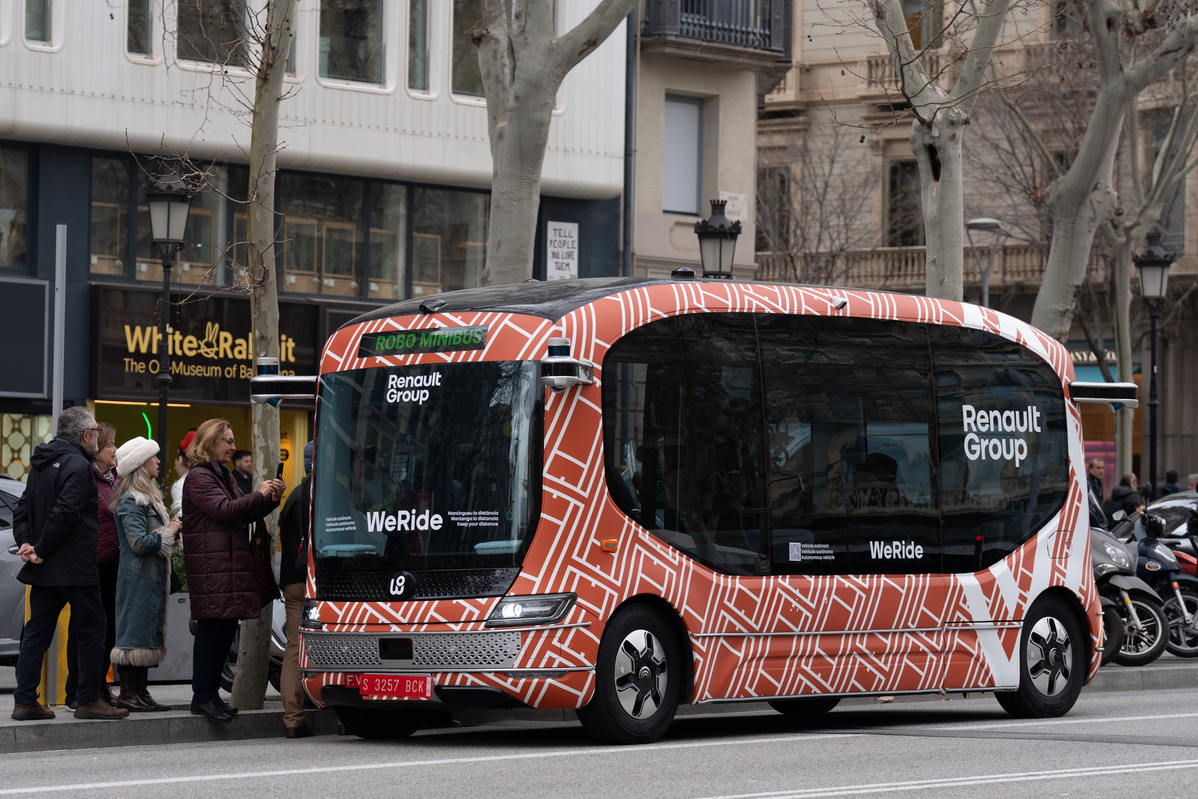
A WeRide driverless minibus is seen in Barcelona, Spain in March. DAVID ZORRAKINO/EUROPA PRESS/GETTY IMAGES
Chinese autonomous driving companies are accelerating steps to expand their presence overseas and increase robotaxi fleets — a move which industry experts said will bolster the large-scale commercial application of self-driving vehicles globally.
The enterprises boast relatively abundant experience in diversified road testing and operational scenarios from high-density urban centers to suburban areas. Meanwhile, ensuring the safety of robotaxis remains a top priority given the complex traffic conditions and urban environments in different countries, they said.
Chinese bike-sharing platform Hellobike has entered the robotaxi market by establishing a joint venture with fintech giant Ant Group and battery behemoth Contemporary Amperex Technology Co Ltd.
The three companies have invested more than 3 billion yuan ($418.3 million) in the new firm as an initial investment, Hellobike said in a statement on Monday.
With a registered capital of 1.29 billion yuan, the new Shanghai-based company will focus on the research and development of Level 4 autonomous driving technology, and its safe application and commercialization. Level 4 vehicles can intervene if there is a system failure, and do not require human assistance in most circumstances. Manual override options are also available.
Hellobike's entry into the robotaxi market offers a glimpse into the fiercer competition in China's autonomous driving sector. Chinese self-driving technology companies are ramping up efforts to make inroads into overseas markets.
Apollo Go, Baidu Inc's autonomous ride-hailing platform, has signed a strategic cooperation agreement with the Roads and Transport Authority of Dubai, the United Arab Emirates, to launch autonomous driving testing and services in the city.
It will deploy 100 fully autonomous vehicles in Dubai by the end of this year, with plans to expand the fleet to no fewer than 1,000 by 2028. The move marks Apollo Go's first international fleet deployment outside the Chinese mainland and Hong Kong and its first entry into the Middle East.
Moreover, it has inked a strategic partnership with AutoGo, a UAE-based autonomous mobility solutions company, with the goal of deploying the largest fully driverless fleet in Abu Dhabi, capital of the UAE.
Chinese self-driving company Pony.ai has accelerated its global expansion pace. The company announced in May that it has inked a strategic partnership with US-based ride-hailing service provider Uber to deploy its robotaxis onto the latter's platform.
The partnership will be first rolled out in a key market in the Middle East later this year, with a goal of scaling deployments to additional international markets in the future, said Pony.ai.
Autonomous driving startup WeRide recently announced the launch of fully driverless robotaxi trial operations in Abu Dhabi, the first deployment of its kind in the Middle East. Starting this quarter, a fleet of its robotaxis will be piloted on public roads without a safety driver, marking a major milestone in the advancement of smart mobility in the city.
"China is at the global forefront of R&D and the application of self-driving technology, and the accelerated expansion of Chinese self-driving companies abroad will be conducive to propelling the commercialization of the cutting-edge technology globally," said Zhang Xiang, a visiting professor from the engineering department at Huanghe Science and Technology University.
Zhang said authorities in the Middle East and some European countries have a relatively open attitude toward autonomous driving and are promoting the testing and use of robotaxis thanks to technological advancements and cost reductions.
"Chinese self-driving enterprises have strong technical prowess and accumulated rich testing and operational experience in the domestic market. They aspire to play a bigger role in the international autonomous vehicle field by leveraging their strengths," said Zhu Keli, founding director of the China Institute of New Economy.
 Editor:Qiu Xiaochen
Editor:Qiu Xiaochen